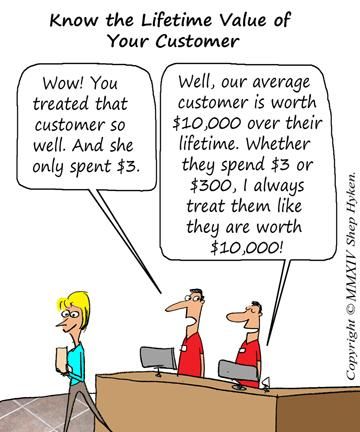Do You Know the Lifetime Value of Your Customers?

Four in ten senior executives in larger companies don't know the lifetime value of their customers. Not only did 40% of the leadership surveyed not know the financial value of their customers, over half of them don't plan to. In other words, they don't care or see the merit in this important number.
This absolutely surprises me. If the leaders of these organizations don't know, then you can expect that the employees don't know either. Yet when employees know and have clarity about the lifetime value of the customer, they can make better customer-focused decisions.
Let's look at a simple example that most of us can understand. We've all gone grocery shopping. Several studies indicate that an average customer of a grocery store spends from $80 to $200 each week. Let's make this easy. Let's say that the average customer spends $100 each week. Assuming he or she takes a couple of weeks off for vacation, that's 50 weeks they buy groceries, which comes out to $5,000 each year. But, it's even more than that. Because we're talking about the lifetime value – not the annual value.
The average family moves about every seven years. Assuming they move out of the neighborhood, that means that the average customer or family is worth about $35,000 in business over those seven years. So, the next time they complain about a carton of spoiled milk, give them their money back! Is it worth upsetting a customer over a few dollars, when they are worth $35,000? Of course not!
Once you know the lifetime value, you must know what to do with it. Here is a six step solution:
1. Calculate: Determine the lifetime value of the customer. How much the average customer spends each time they buy, how often they buy in a year, and how many years do they buy? This is a bit of a simplification, but a good start.
2. Communicate: Share this information with employees so they can make better decisions.
3. Demonstrate: Give them examples of the kinds of decisions they can make; refunds, exchanges, upgrades, and more.
4. Recognition: Recognize when employees make good decisions. Encourage them to do more of the same.
5. Teach: Conversely, if an employee makes a bad decision, help the employee feel good about trying to make the right decision and confident about what to the next time.
6. Share: Tell the story. Share the good – and even the bad – examples that demonstrate how employees are making decisions based on the lifetime value of the customer. It's part of their ongoing training. In short, knowing the value of a customer makes sense. Here is a simple guideline: Manage the interactions you have with your customers with the lifetime value in mind, with each and every interaction.
In short, knowing the value of a customer makes sense. Here is a simple guideline: Manage the interactions you have with your customers with the lifetime value in mind, with each and every interaction.
 Shep Hyken, CSP, CPAE is a customer service expert, hall-of-fame speaker and New York Times and Wall Street Journal bestselling author. He works with organizations to build loyal relationships with their customers and employees. He is also the creator of The Customer Focus, a customer service training program that helps organizations develop a customer service culture and loyalty mindset. For more information contact (314) 692-2200 or www.Hyken.com
Shep Hyken, CSP, CPAE is a customer service expert, hall-of-fame speaker and New York Times and Wall Street Journal bestselling author. He works with organizations to build loyal relationships with their customers and employees. He is also the creator of The Customer Focus, a customer service training program that helps organizations develop a customer service culture and loyalty mindset. For more information contact (314) 692-2200 or www.Hyken.com


